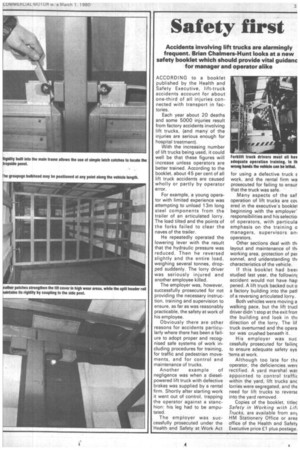Safety first
Page 39

If you've noticed an error in this article please click here to report it so we can fix it.
Accidents involving lift trucks are alarmingly frequent. Brian Chalmers-Hunt looks at a new safety booklet which should provide vital guidanc for manager and operator alike
ACCORDING to a booklet published by the Health and Safety Executive, lift-truck accidents account -for about one-third of all injuries connected with transport in factories.
Each year about 20 deaths and some 5000 injuries result from factory accidents involving lift trucks, (and many of the injuries are serious enough for hospital treatment).
With the increasing number of lift trucks being used, it could well be that these figures will increase unless operators are better trained. According to the booklet, about 45 per cent of all lift truck accidents are caused wholly or partly by operator error.
For example, a young operator with limited experience was attempting to unload 13m long Steel components from the trailer of an articulated lorry. The load tilted and the points of the forks failed to clear the naves of the trailer.
He repeatedly operated the lowering lever with the result that the hydraulic pressure was reduced. Then he reversed slightly and the entire load, weighing several tonnes, dropped suddenly. The lorry driver was seriously injured and another employee killed.
The employer was, however, successfully prosecuted for not providing the necessary instruction, training and supervision to ensure, as far as was reasonably practicable, the safety at work of his employee.
Obviously there are other reasons for accidents particularly where there has been a failure to adopt proper and recognised safe systems of work including procedures for training, for traffic and pedestrian movements, and for control and maintenance of trucks.
Another example of negligence was when a dieselpowered lift truck with defective brakes was supplied by a rental firm. Shortly after starting work it went out of control, trapping the operator against a stanchion: his leg had to be amputated.
The employer was successfully prosecuted under the Health and Safety at Work Act
for using a defective truck E work, and the rental firm wa prosecuted for failing to ensur that the truck was safe.
Many aspects of the saf operation of lift trucks are co% ered in the executive's booklei beginning with the employer' responsibilities and his selectiot of operators, with particula emphasis on the training o managers, supervisors ant operators.
Other sections deal with tht layout and maintenance of thl working area, protection of per sonnel, and understanding thi characteristics of the vehicle.
If this booklet had beer studied last year, the followim accident would not have hap pened. A lift truck backed out o a factory building into the patl of a reversing articulated lorry.
Both vehicles were moving a walking pace, but the lift trucl driver didn't stop at the exit non the building and look in thc direction of the lorry. The lit truck overturned and the opera tor was crushed beneath it.
His employer was suc cessfully prosecuted for failinc to ensure adequate safety sys 'terns at work.
Although too late for the operator, the deficiencies were rectified. A yard marshal wat appointed to control traffic within the yard, lift trucks aric lorries were segregated, and thE need for lift trucks to reverse into the yard removed.
Copies of the booklet, titlec Safety in Working with Lin Trucks, are available from any HM Stationery Office or area office of the Health and Safety Executive price £1 plus postage.
















































































































